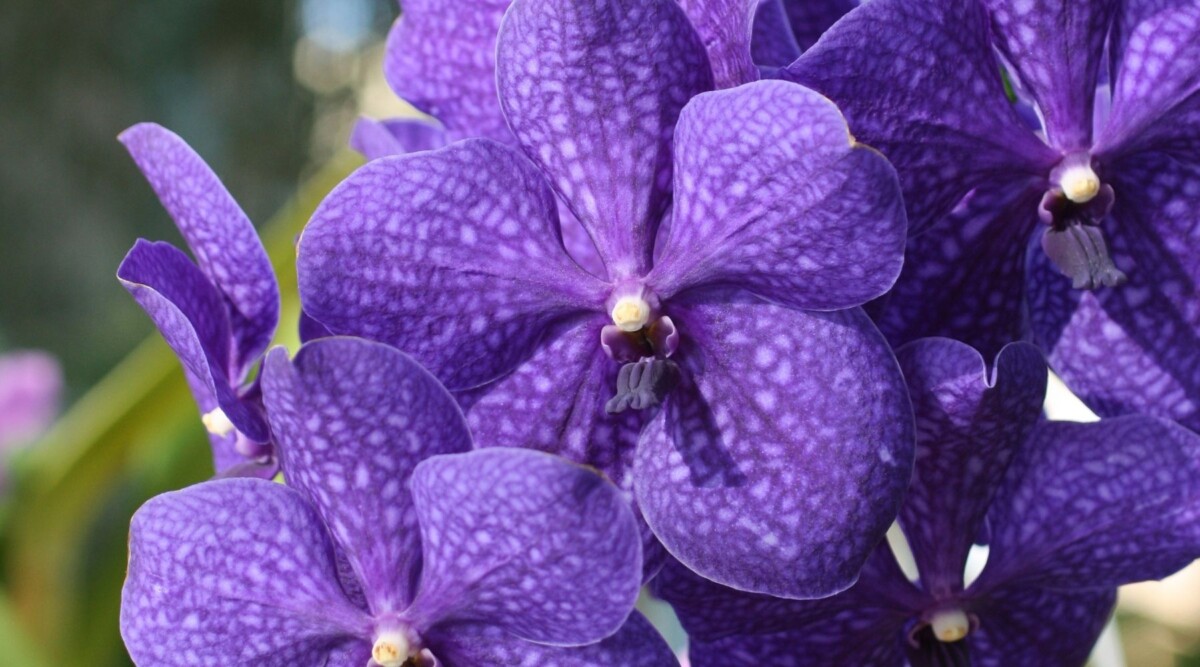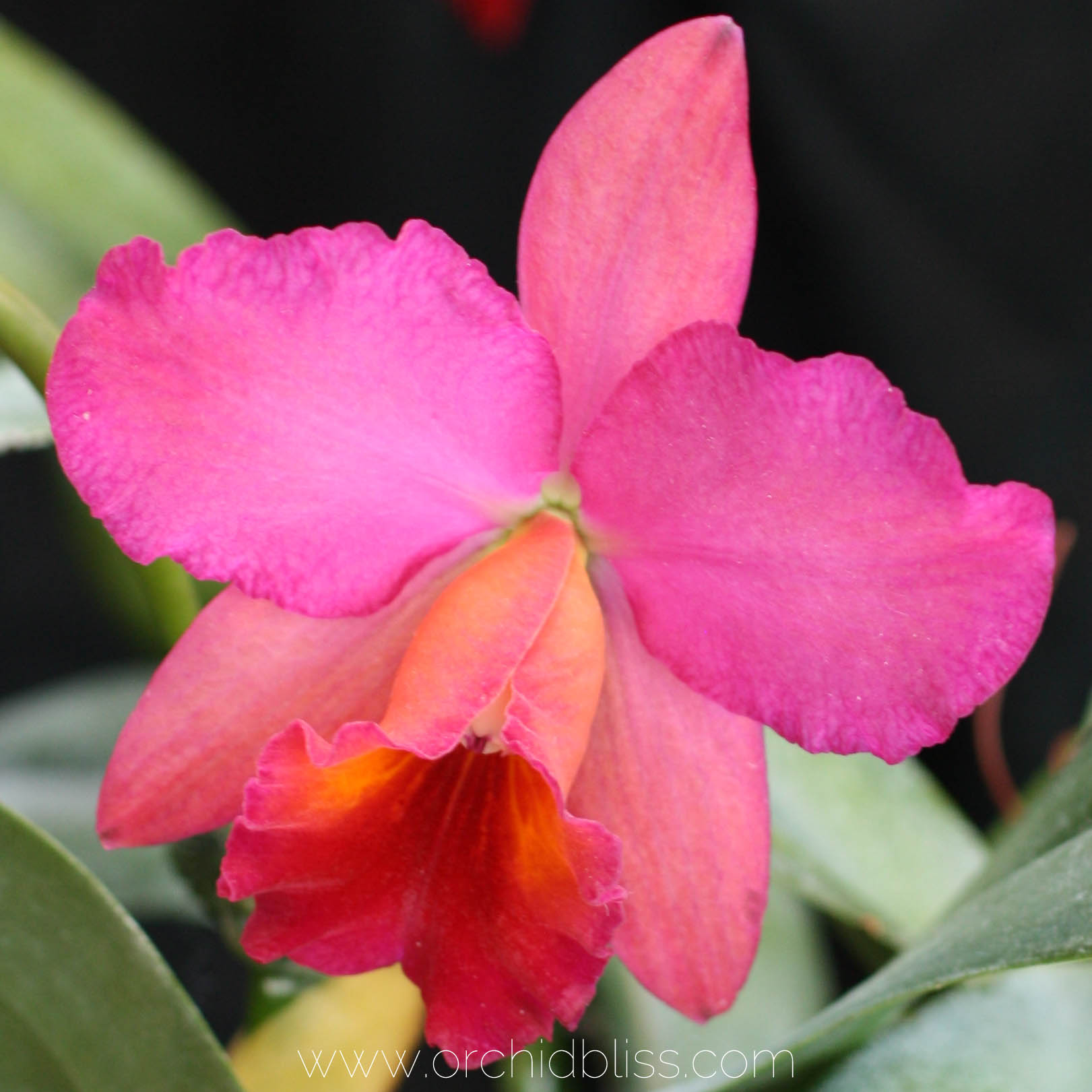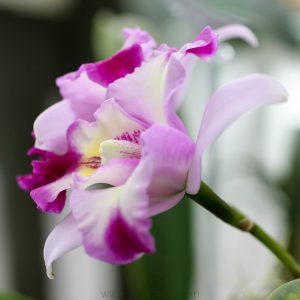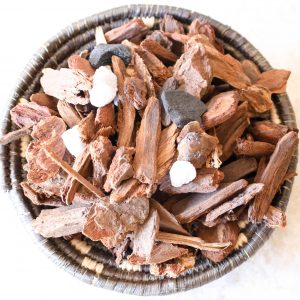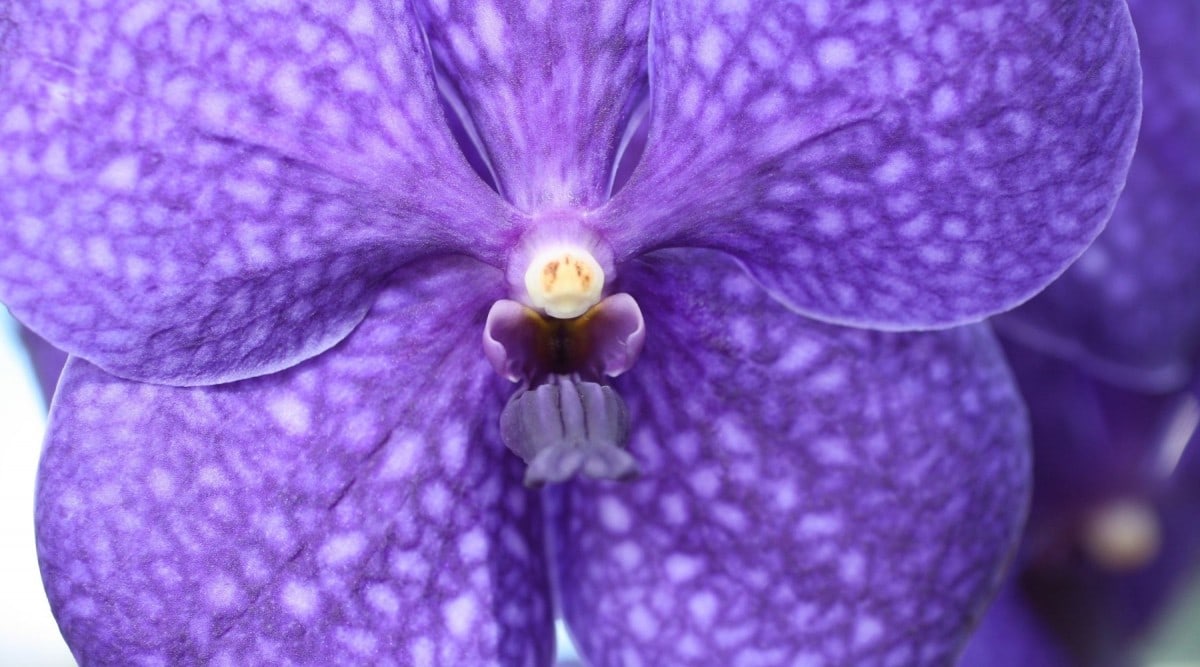
With so many species of orchids, it is challenging to figure out the right care for each one. Vanda orchids, in particular, have slightly different needs than the average orchid. For example, they prefer to hang in little to no soil, whereas many other orchids live in pots.
Some top tips on caring for Vanda orchids include: hanging them correctly, frequent watering in warm weather, using root cuttings to propagate, using 20-20-20 fertilizer, using the right soil, potting, and repotting carefully and only when necessary, and keeping humidity and temperature correct.
The following article will show you how to care for your Vanda orchid. We will look at watering, fertilizing, propagating, hanging, and more. There will also be advice on the types of Vanda orchids and some information on orchids in general.
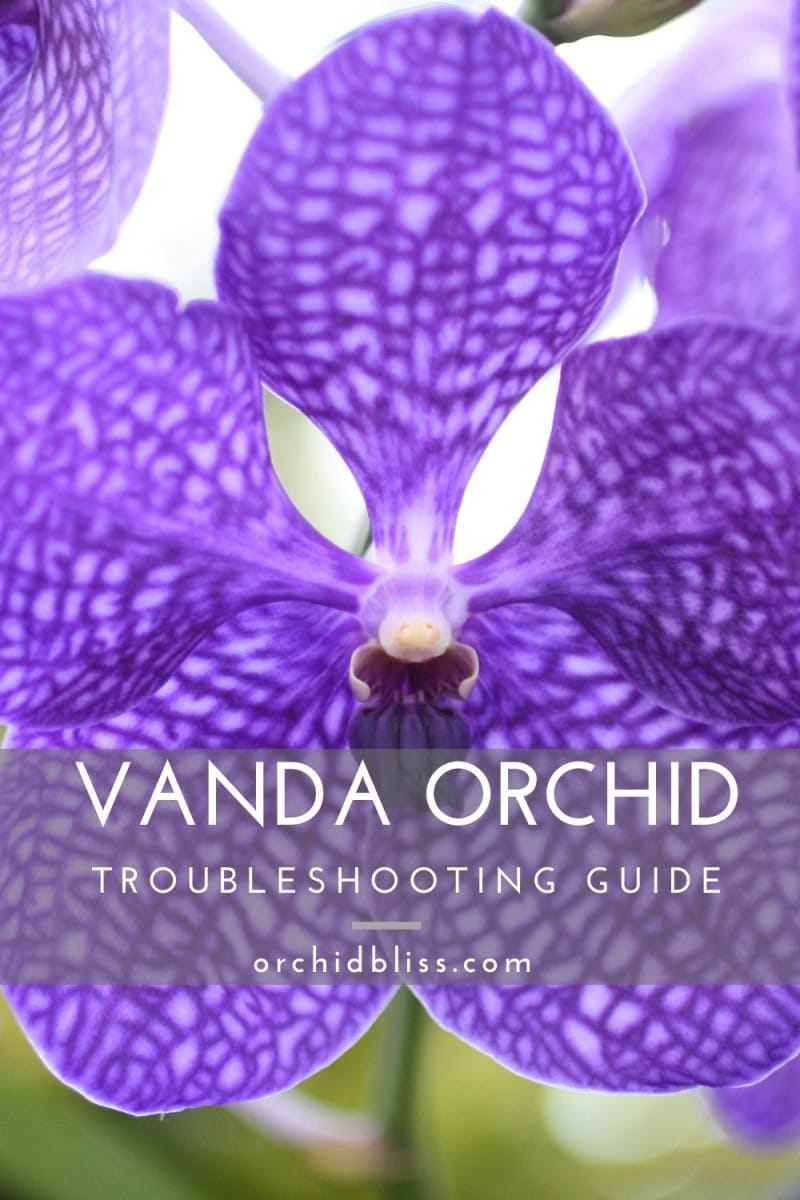
What Are Orchids?
Orchids are flowering plants with over 28,000 species in the Orchidaceae family, and, amazingly, there are four times as many orchid species as there are mammal species. The first orchids developed around 84 million years ago, making orchids one of the oldest plant types.
Almost all orchids have one petal that forms a lip, and most lip petals are found at the plant’s bottom. However, some species of orchid have a lip petal at the top of the flower. You can recognize an orchid by its three-petaled flower, one of which will be larger and form a lip. The lip of an orchid may be a different color from the rest of the flower.
Orchids are favored for their beautiful colors and fragrant scents. They are found on every continent except Antarctica, although they are most common in tropical countries.
What Is a Vanda Orchid?
Vanda orchids are monopodial orchids, which are a type of orchid that grows upwards with one main stem. The genus Vanda consists of around 80 species. It grows across East and Southeast Asia, New Guinea, Queensland, and some West Pacific islands.
Vandas were discovered in 1613 and named ‘tiao hua’ or ‘air plant’ because of their aerial root system. Although Vanda orchids like to hang from baskets in your home, they will also adapt to living wrapped around trees. The aerial root systems act like sponges, absorbing plenty of water, so you’ll need to take care when watering your Vanda orchid.
As an epiphytic plant, your Vanda orchid will have organisms growing on it that help it access nutrients and moisture. However, some species of Vanda orchid grow in soil like regular orchids.
The Vanda orchids are highly prized by horticulturists and gardeners alike due to their beautiful flowers. And while all Vanda orchids are monopodial, some have incredibly long stems, even reaching lengths in the meters. However, plenty of them also have much shorter stems, so do not be put off buying that gorgeous Vanda you want.
You can watch an excellent video on Vanda orchids by Gardening is my Passion here:
What Are the Types of Vanda Orchid?
With over 80 species in the genus, Vanda orchids come in many shapes and sizes. Nevertheless, there are three main types of Vanda orchids — strap-leaved, terete, and semi-terete. Each of these types has slightly different needs because of the way their leaves absorb sunlight.
- Strap-Leaved: The strap-leaved Vandas have broad, flat leaves, which readily absorb sunlight. Vanda orchid leaves should be mid-green and not dark green. For your strap-leaved Vanda, you will want to make sure it sits in partial shade, so you are not giving it too much sunlight for long periods.
- Terete: Terete-leaved Vandas have thinner, pencil-like leaves and require full sunlight. Do not keep your terete-type Vanda orchid in the shade. However, if you are growing your Vandas in a greenhouse, you can provide about 25-35% shade. Remember to allow for less light in winter and remove the shade from your orchids during overcast weather.
- Semi-Terete: Vandas with semi-terete leaves are somewhere between the two other types. The leaves are broader than terete-leaved but thinner than strap-leaved. You will need a careful balance between plenty of light and some shade for semi-terete Vandas, depending on the leaves of your species.
What Colors Do They Come In?
Vanda orchids come in any color, although some colors of orchids are rare and have restrictions on trade. Common colors of Vanda orchids include:
- Yellow-brown
- White
- Green
- Orange
- Red
- Burgundy
- Purple
Many Vandas have patterns or markings across their petals and a spurred lip on one petal. In particular, Vandas commonly have tiny spots in varying shades to the primary petal color.
Blue Vanda Orchids
Blue orchids are incredibly rare, even in the Vanda genus. There are only one blue-colored orchid species (Thelymitra crinita), known as the Blue Lady Orchid, the Queen Orchid, or the Lily Orchid. Although many Vanda species have the word ‘blue’ in their name, the Blue Lady is not a Vanda orchid.
Vanda Orchids Care Tips
Vanda orchids are beautiful plants, but they require some particular care. For example, Vandas are hanging orchids and do not do well potted in an upright position. You will also want to be careful when repotting and watering your orchids. Vanda orchids are ideal hanging basket plants, but they do require lots of sunlight and some humidity.
freebie
GET YOUR VANDA ORCHID CARE CARDHow to Hang Vanda Orchids
Vanda orchids have extensive aerial root systems and need to be hung or kept in loose net pots. This method of handing orchids provides stunning displays of color and fragrance and will attract lots of bees and butterflies to your garden.
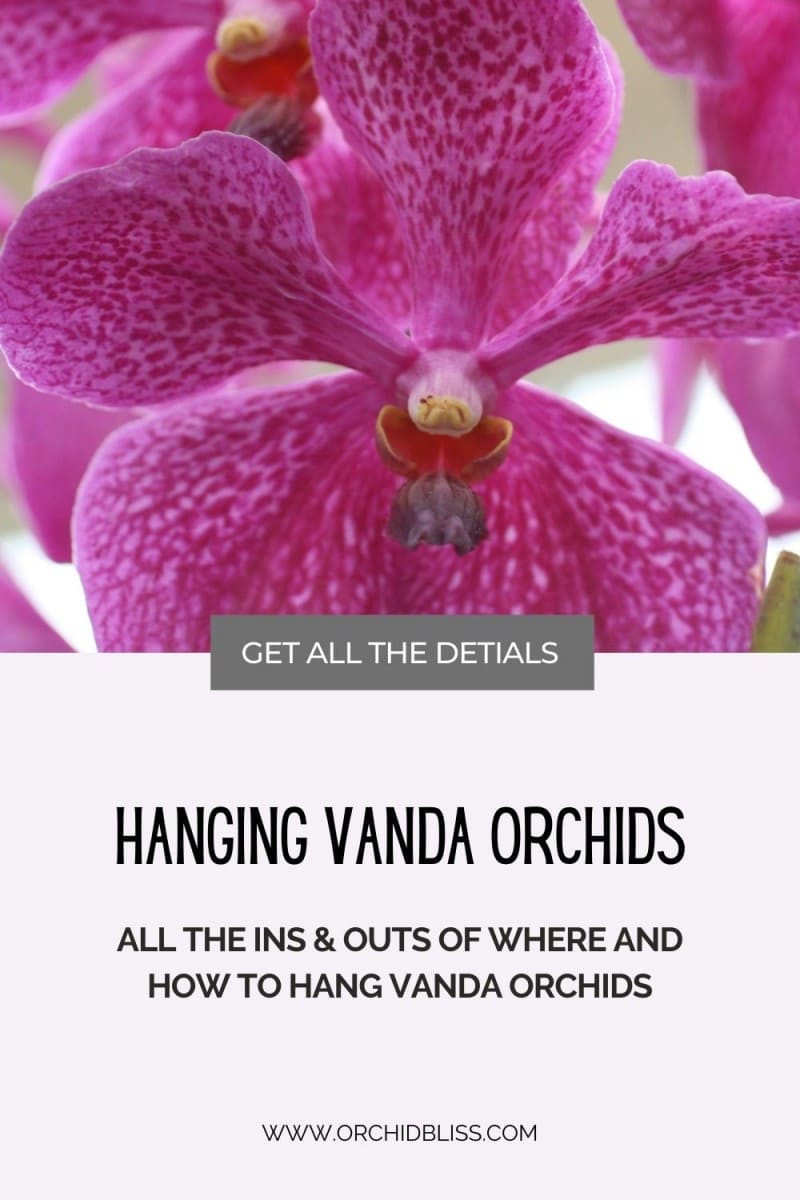
If you are looking for the perfect Vanda orchid basket, we recommend this Slatted Cedar Vanda Basket from Amazon.com. For vandas, use a slatted basket that is 8-12″ in diameter.
You can also make a slatted basket for Vandas by using up old baskets or crates you have at home.
Some other ways to hang Vanda orchids include:
- Wire or plastic baskets with slats or substantial holes
- Tying your Vandas to driftwood and hanging the wood from the ceiling
- Plastic pots punctured with holes
Where to Hang a Vanda Orchid
Hanging your Vanda orchids in the right location is crucial to their well-being. If your orchid has flatter broader leaves, it will need partial shade and lots of sunlight. However, if its leaves are more tubular or pencil-like, it will need a lot more light. Most orchids do well outdoors in high light parts of the world, but you can keep them in a greenhouse or light indoor room too.
How to Water Vanda Orchids
You will need to water your Vanda often, especially during the warmer months. During fall and winter, you should reduce watering. Vanda orchids should always have moist roots, and they should never be too soggy. If you use any soil medium with your Vanda orchids, make sure it is loose and drains well. Generally speaking, it is not too often to water vanda roots daily. If for some reason, you missed watering your vanda and it dries out, soak it in a 5-gallon bucket for about a half-hour.
How to Propagate Vanda Orchids
If you would like to breed, or propagate, Vanda orchids, you will need to take a cutting of the tip of the plant, where the aerial roots start to emerge. When you re-pot the cutting, allow enough water so that you can see it drain through the holes in your post, and then wait for the soil to dry out before watering the root again.
How to Fertilize Vanda Orchids
Fertilizer is excellent for Vanda orchids, but make sure the product you are using is safe for orchids. Dyna-Gro offers a great fertilizer for orchids. In warmer weather, you can apply fertilizer once a week at quarter strength. During cooler weather, use fertilizer every 2-4 weeks. Fertilizing a vanda by soaking it in a 5-gallon bucket of water every few months – especially when new leaves and roots are growing is a great way to fertilize occasionally.
To promote Vanda orchids’ flowering, swap your fertilizer for a product high in phosphorus (3-12-6) every third time you fertilize the plants.
If you are looking for an excellent orchid fertilizer, we recommend Dyna-Gro, available from Amazon.com. It promotes flowering and leaf color, as well as health in your plants.
What Kind of Potting Medium Do Vanda Orchids Need?
As Vanda orchids are epiphytic plants, they need very little potting media. You can use osmunda (tree fern roots), coarse fir bark, coconut husks, and horticulture charcoal. Or, you can skip potting media altogether and place the vanda in a basket, allowing the roots to grow out of the basket. A useful tip when potting Vanda orchids is to ensure good air circulation. You will also want to make sure water drains away quickly, or you will harm your orchids.
How to Pot or Repot Vanda Orchids
You should try to avoid repotting Vanda orchids unless necessary. If you do repot a Vanda, do it in the spring, as this is the best time of year for the plant to tolerate it. You will need to re-pot your Vanda orchid if the potting medium breaks down or becomes waterlogged.
The least traumatic, and most common way to re-pot a vanda orchid is to simply place the vanda orchid in a larger basket – old basket and all.
If you do decide to extract your vanda from its former basket, place the whole thing into a container of water before repotting. Newly repotted orchids should be kept somewhere humid, with drier roots, until they have settled in a bit. Your repotted Vanda will also benefit from a little more shade than usual.
How Much Humidity Do Vanda Orchids Need?
Like most orchids, Vandas require 80% humidity. Humidity refers to water vapor in the air, and it is usually at its highest at night, dawn, and dusk. When orchids breathe, it’s called transpiration, which is where they take in and release different gases. Orchids have pores, or stomata, on their leaves that allow for transpiration. When orchids open their stomata, they lose water, which they replace with water vapor from humid air.
How to Check Humidity for Vanda Orchids
You can use a humidistat or humidity gauge to check humidity, like the one I use from Amazon.com. It has industrial-level accuracy and an easy-to-read display. You can mount it on the wall in several ways, including by using magnets. It holds records of your minimum and maximum levels too.
How to Increase Humidity for Vanda Orchids
You can increase humidity by placing your Vanda plants in more humid locations, such as a greenhouse. However, adding a water-filled tray or two to the room can increase humidity. You may also want to use a humidifier. Humidifiers are easy to get at your local hardware store, but your local garden store may sell them too.
What Temperature Is Best for Vanda Orchids?
The optimum temperature for Vanda orchids is 55 – 95 F (12.3 – 35 ℃) in the daytime and 60 – 70 F (15.5 – 21.2 ℃) at night. Thermometers are always useful in a greenhouse, and you can find one at a reasonable price from pharmacists or supermarkets. Check the details of your particular species of orchid for which temperatures they prefer.
Common Problems With Vanda Orchids and How to Fix Them
Orchids are not difficult to care for, but you will have to do your research first. They can be picky about things like temperature and will require some humidity. With so many orchid species, you will want to do some careful research about the individual species you have to cater to their specific needs.
Too Much Light
Many people make the mistake of giving their orchids too much light. Orchids come with a few varieties of leaves, some of which need more sunlight than others. Too much sunlight causes sunburnt leaves, suppressed blooming, and missed or incorrect cues to bud.
To fix this issue, give your orchid partial shade. This is particularly important if you have strap-leaved Vanda orchids, as the broader leaves take in much more sunlight than plants with narrower leaves do and thus need less sunlight.
Not Enough Light
Orchids that are kept in the shade may refuse to bloom or may only bloom once. To rectify this, relocate your orchid to a sunnier place, or buy an artificial lamp, such as a Grow Light for indoor plants, available from Amazon.com. You can switch between the regular light spectrum and the red-blue light spectrum to better fit your plants.
Temperature Is Too Hot
Although orchids love slightly hotter temperatures, there are variances across species. You will also find orchids thrive better in cooler temperatures at night.
Temperature Is Too Cold
Vanda orchids thrive in warmer climates, and they prefer temperatures of 55 – 95 F (12.3 – 35 ℃) during the day. You can provide slightly cooler temperatures at night, as this is more natural for an orchid. Cooler nights are essential before the orchid’s blooming season, so consider moving your plants to a cooler room two weeks before blooming.
If you are struggling to get the temperature right for an orchid, move them somewhere sunny or less drafty. Always check the recommended temperatures for the exact species of orchid you are growing.
Unstable Temperatures
Just as being too hot or too cold can stunt an orchid, temperatures that vary widely over short periods can also negatively impact it. Vanda orchids are tropical plants, and as such, are sensitive to cold. Any plant will struggle in areas that fluctuate between warm and drafty, and your orchids are no different. Keep your orchids in stable temperatures, with a 10-degree temperature drop at night is ideal
If a vanda orchid loses its leaves, that area on the stem will remain bare. New leaves will not grow back in that area. It well cared for new leaves will grow above the bare spot – but not where the leaves were lost. Often a cold snap is responsible for leaf drop.
Air Movement
Since vanda orchids need 80% humidity to survive, providing excellent air movement is essential to deterring bacterial and fungal infections. To provide air movement, simply turn on a fan to its lowest setting, and point it away from your orchids.
Low Humidity
When humidity is low, your orchid loses more water than it can absorb. As a result, it closes its pores and stops absorbing carbon dioxide. Therefore, your orchid will stop breathing and essentially suffocate.
You can purchase humidifiers to add water to the air, which will help increase humidity. It may also help to keep your orchids in a greenhouse. Devices called humidistats help monitor the moisture of the area.
Wrong Location
Some plants do better in some locations than others. For example, Vanda orchids prefer to hang in a basket or from a beam.
If your orchid is failing to thrive where it is, try gradually increasing its exposure to sun or shade. However, do not move your orchid around too often, or it will become unsettled and stop thriving.
Wrong Soil
Different varieties of orchids, like various potting media. Some Vanda orchids, for instance, like osmunda (dried fern), but other orchids may not thrive with osmunda.
Vanda orchids do not require traditional soil because they are epiphytic. Never pot an orchid in traditional potting soil. Even semi-terrestrial and terrestrial orchids tend to grow in rocks or leaf litter and along the surface of the earth.
Wrong Fertilizer
Vanda orchids do best with fertilizers that contain nitrogen that is non-urea-based. This is because urea depends on chemical reactions between the urea and the soil. Since epiphytic orchids do not use traditional soil, the orchid will not receive the benefit of nitrogen. Note that urea-based fertilizers will not harm the orchid. They simply will not be able to absorb it.
Requires Repotting
If your Vanda orchid needs repotting, this might explain why it is failing to thrive. Another problem you may have is repotting your Vanda too often or at the wrong time. Only repot your Vanda when it is necessary, and be careful not to damage the roots. Again, often the best way to “repot” a vanda orchid is simply to place it in a larger cedar basket without removing it from its original basket.
Signs that your orchid needs repotting include:
- Needing new soil medium
- Tight or tangled roots
- Too large for the current container
- Soft roots
Too Much Water
Vanda orchids need frequent watering in the warmer months and less often in the colder months. Too much water will essentially suffocate your orchids, and they may die. If you think you have overwatered your orchids, simply stop watering until the soil has almost dried out. Always keep Vanda orchids in a pot with drainage holes for water. If your orchid is potted in a slotted basket with plenty of drainages, you will have difficulty overwatering.
Not Enough Water
A dry orchid probably will not thrive, so if you find your Vandas are looking a little limp, test the soil medium. If it is bone dry, they need watering. You can use a jug or watering can, and some people like to spritz their plants with water from a spray bottle.
If your plant is underwatered, it will likely shrivel up and go yellow, brown, or yellowish-brown. Plants do this to retain as much water as possible in the leaves at the flower’s expense.
It Is the Wrong Season for the Species
Your orchid might be perfectly healthy; it is just off-season for its species. Some types of orchids bloom annually, but many bloom several times a year. Check the details of the species you have to find out when it should be blooming. This is essential information to know because it allows you to monitor the health of your orchids better.
An excellent way to keep track of all your plants is to use a gardener’s journal or logbook. I like the New York Botanical Garden’s logbook from Amazon.com. It will last you five years, and it is waterproof, so you will never have to worry about soggy pages while you water your plants. Keeping a journal of your garden will give you plenty to look back on in years to come and could even become a new family heirloom that you could leave your grandchildren.
How Do You Know if Your Orchid Is Dead?
No gardener wants to wake up in the morning and find their beautiful orchids dead in their pots. Some signs that your orchid is unhealthy or dying include:
- Turning yellow or brown
- Shedding leaves
- Withered flowers
As an orchid dies, it sheds its leaves; however, some orchids will regrow shed leaves (but not in the same spot). Nevertheless, evergreen orchid species will only lose their leaves when they die, and they will not grow back. Another sign of death in orchids is dropped petals or buds.
Where to Buy a Vanda Orchid?
You can purchase Vanda orchids from any garden seller, but you may prefer to find a specialized orchid seller for specific species. Vanda orchids can sometimes be ordered online or picked up in non-gardening stores. However, you should always check the label and condition of the plant.
Remember that some orchid species should not be exported from their country of origin due to their status as endangered species. If you have concerns about the origins of something for sale, do not buy it.
warm climate orchids
BUY VANDA ORCHIDS
Are Vanda Orchids Endangered?
Unfortunately, many Vanda orchids are endangered, such as Vanda coerulea, which grows in Assam and the Khasi hills. The rarer species’ of Vanda orchids suffer from habitat destruction, as they favor forest areas. Many of these species cannot be exported from the wild and should not be for sale in stores.
Can You Export Wild Vanda Orchids?
As all orchid species are on the Convention on International Trade in Endangered Species (CITES) list, many species cannot be exported from the wild. Most orchids for home use are bred outside of their natural habitat. Vanda coerulea, in particular, should never be taken out of its natural surroundings.
Why Choose a Vanda Orchid?
Vanda orchids are celebrated in the horticultural world for their beauty and are among the top five genera of orchids hobbyists enjoy growing. The Vanda orchid comes in an array of stunning colors and patterns and makes a beautiful hanging basket plant. You can even hang a Vanda from your ceiling on a driftwood beam.
Download Your Own Care Card
Growing orchids is rewarding, though sometimes frustrating. To add more fun and less discouragement, I’ve created an easy-reference, downloadable, and free Vanda Care Card with information on how to care for cattleyas. To get yours, CLICK HERE.
These Care Cards cover all the essential information that we’ve talked about right here, including temperature, light, humidity, water, fertilizing, potting, and media.
This way, you can easily access the information you need to give your Vanda orchids the very best care.
Resources
If you are curious about any of the products, such as potting mix, fertilizer, and artificial lights, I personally use and recommend to grow orchids successfully, CLICK HERE.
Related articles
Growth Patterns of Monopodial and Sympodial Orchids
Knowing this will help you better water and pot your orchids.
ReadHow to Give Your Orchids the Right Light and Watch Them Bloom
Learn about natural sunlight and artificial lights, including fluorescent and LED lights, to grow orchids.
ReadSources
- Gardening Know-How: Growing Vanda Orchids – Learn About The Care of Vanda Orchids
- North of England Orchid Society: All about Vanda Orchids and how to grow them
- Oregon Orchid Society: What is an Orchid?
- Merriam-Webster: Orchid
- Wikipedia: Orchidaceae
- Wikipedia: Vanda
- Brilliant Orchids: Vanda Orchids: Beginner’s Care Guide
- Florgeous: Vanda Orchids: Types, Pictures, How to Grow and Care
- American Orchid Society: Vanda Culture Sheet
- Orchids Info: Vanda Orchids – Orchid which is widespread in nature
- SFGate: Vanda Propagation
- Orchid Care Zone: Vanda Orchids – 5 Potting Tips Your Vandas Will Love
- Gardeners: How to Grow Orchids, Growing Orchids, Orchid Care
- Orchid Bliss: 4 Quick Steps to Increase Humidity
- Beautiful Orchids: Orchid Care Tips: Humidity
- RePot Me: Orchid Care: 10 Easy Tips
- SFGate: How to Tell When an Orchid is Dead
- Orchids Info: Vanda Orchids

